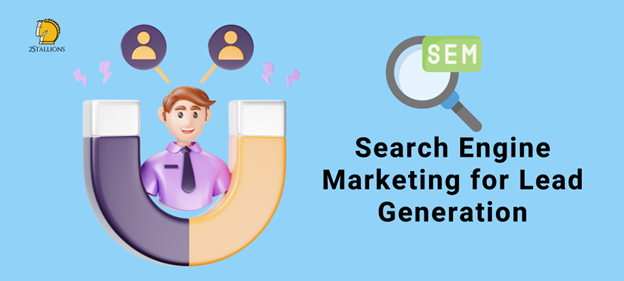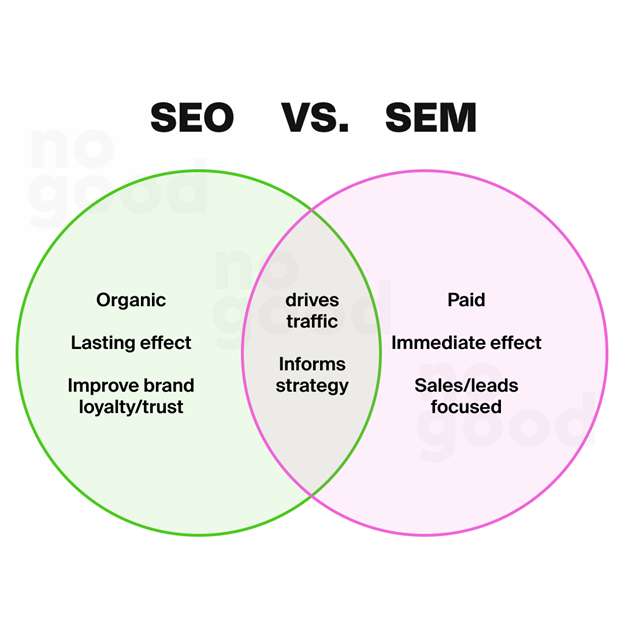SHARE

Search engine marketing (SEM) has become a pivotal strategy for businesses aiming to generate leads in the digital age. By leveraging the power of search engines, companies can attract, engage, and convert potential customers. But how exactly does SEM aid in lead generation? Let’s delve into this intriguing topic.
Understanding Search Engine Marketing
Before we delve into the specifics of how SEM aids in lead generation, it’s crucial to understand what SEM is. Search engine marketing is a digital marketing strategy that aims to increase a website’s visibility in search engine results pages (SERPs) through paid advertising. SEM involves the promotion of websites by increasing their visibility in search engine results pages primarily through paid advertising. It’s a powerful tool that allows businesses to put their products or services in front of potential customers who are actively looking for them.

Source: Nel, L. (2023, July 31). SEO Vs. SEM: How The Two Work Together To Optimise Brand Visibility.
The Difference Between SEO and SEM
While both search engine optimisation (SEO) and SEM aim to increase visibility in search engines, they do so differently. SEO involves optimising your website to rank higher in organic search results, while SEM revolves around using paid advertising to appear in the sponsored section of SERPs. Both strategies are crucial for lead generation, but SEM allows for more immediate results, making it a popular choice for businesses looking to quickly increase their online visibility and generate leads.
How SEM Contributes to Lead Generation
Now that we’ve covered the basics of SEM, let’s explore how it aids lead generation. SEM can contribute to lead generation in several ways, including targeting specific demographics, increasing brand visibility, and driving targeted traffic to your website. One of the primary benefits of SEM is the ability to target specific demographics. Using SEM, you can ensure that your ads appear to potential customers actively searching for your products or services. This targeted approach can significantly increase the chances of converting these users into leads.
Source:Birkett, A. (2022, August 9). Brand Visibility—What is it? How can I increase it? Semrush Blog
Increased Brand Visibility
Another significant advantage of SEM is increased brand visibility. Your brand gains exposure to a large audience by appearing at the top of SERPs. This increased visibility can lead to higher brand recognition, which can, in turn, lead to more leads and conversions. It’s also worth noting that SEM can help to build trust with potential customers. By appearing at the top of SERPs, your brand can be perceived as more trustworthy, significantly impacting lead generation.
Driving Targeted Traffic
SEM is also a powerful tool for driving targeted traffic to your website. By using specific keywords and phrases in your ads, you can attract users who are actively searching for your products or services. This targeted traffic is more likely to convert into leads, making SEM a highly effective strategy for lead generation. Furthermore, by using SEM, you can control when your ads appear, allowing you to target potential customers at the right time. This ability to control when and where your ads appear can significantly increase your chances of generating leads.
Implementing SEM for Lead Generation
Now that we’ve covered how SEM can aid in lead generation, let’s look at how you can implement this strategy. Implementing SEM for lead generation involves several steps, including keyword research, creating compelling ads, and monitoring and adjusting your campaigns.
Keyword Research
Keyword research is a crucial step in implementing SEM for lead generation. By identifying the keywords and phrases that potential customers are using to search for your products or services, you can ensure that your ads appear to the right audience. There are several tools available that can help with keyword research, including Google’s Keyword Planner. These tools can provide insights into the popularity of specific keywords, competition levels, and more.
Creating Compelling Ads
Once you’ve identified your keywords, the next step is to create compelling ads. Your ads should be engaging and relevant, and include a clear call to action (CTA). A compelling CTA can significantly increase the chances of users clicking on your ad and converting it into leads. It’s also important to ensure that your ads are relevant to your target keywords. Irrelevant ads can lead to low click-through rates (CTR) and wasted ad spending.
Monitoring and Adjusting Your Campaigns
Finally, it’s crucial to monitor and adjust your campaigns regularly. SEM is not a set-it-and-forget-it strategy. Regular monitoring can help you identify what’s working and what’s not, allowing you to make necessary adjustments to improve your lead generation efforts. By regularly reviewing your campaign performance, you can identify opportunities for improvement and make data-driven decisions to enhance your lead-generation efforts.
Conclusion
Search engine marketing is a powerful tool for lead generation. SEM can significantly enhance your lead generation efforts by targeting specific demographics, increasing brand visibility, and driving targeted traffic to your website. However, implementing SEM for lead generation requires careful planning and execution. By conducting thorough keyword research, creating compelling ads, and regularly monitoring and adjusting your campaigns, you can maximise the effectiveness of your SEM efforts and generate more leads for your business.
Frequently Asked Questions About Lead Generation
What Is Lead Generation?
Lead generation is attracting prospects to your business and increasing their interest through nurturing, all with the end goal of converting them into customers. Some ways to generate leads are through job applications, blog posts, coupons, live events, and online content.
What Is An Example of Lead Generation?
There’s also the increasingly popular lead generation strategy of starting a podcast or seeking out guest podcast appearances. Or you can just go old school and ask your network and current customers for referrals. You can also just stick with the tried and true cold calling (which is the original form of lead gen).
Which Are the 4 Steps of the Lead Generation Process?
- Lead Awareness. This stage is about how leads become mindful of an association and its contributions.
- Lead Education
- Lead Sampling
- Lead Conversion.
What Is a Lead Generation Strategy?
A lead generation strategy is any tactic or action that’s used to attract customers to your business in the hopes of having them interact with your company in some way.
What Is SEM Lead Generation?
If you’re unfamiliar with search engine marketing (SEM), it’s a technique that refers to using paid advertising to market your business in search engine results pages, also known as SERPs. SEM empowers you to advertise within search results, increase website traffic, drive leads, and generate new sales.












